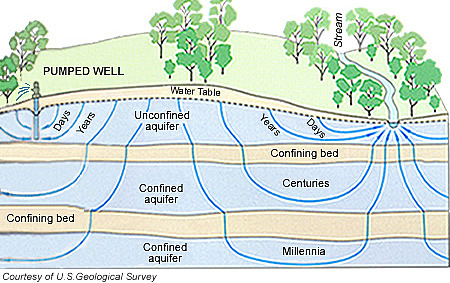GOUNDWATER BASICS - Aquifer
An aquifer is a geologic formation, group of formations, or part of a formation which contains sufficient saturated, permeable material to yield significant quantities of water to wells and springs. There are generally two kinds of aquifers: confined and unconfined.
Unconfined aquifer
An unconfined aquifer, also called a water-table aquifer, is an aquifer which has the water table as its upper boundary. Unconfined aquifers occur near the ground surface. The aquifer in the Yuma area is an unconfined aquifer, composed primarily of sand, gravel, clay and silt sediments deposited by the Colorado and Gila rivers.
Confining bed
A confining bed is a body of distinctly less permeable material that is located above or below one or more aquifers.
Confined aquifer
A confined aquifer is an aquifer that is bounded above and below by confining beds. Confined aquifers generally occur at significant depth below the ground surface.
Hydraulic properties of aquifers
Aquifers store groundwater and transmit it toward a well or other point of discharge. The primary hydraulic property which measures the ease with which groundwater is transmitted by an aquifer or other hydrogeologic unit is called “hydraulic conductivity.” The property which expresses the capacity of an aquifer to take water into and release water from storage is called “storativity” for a confined aquifer and “specific yield” for an unconfined aquifer.
Hydraulic conductivity can vary by orders of magnitude in the subsurface, depending on the size, shape and interconnectedness of the pores or open spaces between solid materials. For example, the size of interconnected pores in sands and gravels is much greater than in finer grained soils such as silts. As a result, sands and gravels generally have a greater hydraulic conductivity than the finer-grained soils.
In a confined aquifer, the pores always remain fully saturated. Water is released from storage in response to a drop in head by two mechanisms:
- Expansion of the water in the pores as water pressure is reduced
- Compaction of the aquifer as water pressure is reduced and stresses between solid grains of the aquifer matrix increase
In an unconfined aquifer, a drop in head results in a release of water from storage by an actual dewatering of pores as the water table declines. As a result of these mechanism differences, the specific yields of unconfined aquifers are much larger than the storativities of confined aquifers. Thus from a hydraulic standpoint, unconfined aquifers are generally preferable to confined aquifers for water supply, because for the same rate of water extraction there is less drawdown over a smaller area with an unconfined aquifer than with a confined aquifer.
Last Updated: 10/15/21

